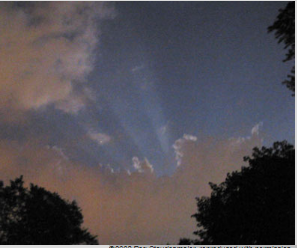Lunar rays
Lunar Rays: A Fascinating Atmospheric Optics Phenomenon
When gazing up at the night sky, we are often captivated by the ethereal glow of the moon. But have you ever noticed the intricate rays that seem to emanate from its surface? These mesmerizing lunar rays, also known as moonbeams or crepuscular rays, are a captivating atmospheric optics phenomenon that can leave us in awe of the celestial world above us.
Lunar rays occur when the moon's light passes through gaps in the Earth's atmosphere, creating a stunning display of light and shadow. These rays are most visible when the moon is close to full, as it provides sufficient brightness to produce the optical effects we observe. While the moon may not always be bright enough to create obvious optical phenomena, it's during these moments that we should keep a keen eye out for 22º halos, paraselenae, coronae, fogbows, and other captivating effects.
To truly appreciate the beauty of lunar rays, one must witness them firsthand. A remarkable photograph captured by Peg Zenko in Wisconsin on June 13th, 2003, showcases the brilliance of these rays. Taken at 22:58 CDT, the image reveals moonbeams resembling spotlights, casting their luminous glow across the landscape. However, as quickly as they appeared, they faded into obscurity as clouds rolled in, reminding us of the ephemeral nature of these celestial phenomena.
The formation of lunar rays is intricately linked to the interplay between light and atmospheric particles. As the moon's light passes through the Earth's atmosphere, it encounters various atmospheric constituents such as dust, water droplets, and aerosols. These particles scatter and bend the moonlight, creating the captivating rays that we observe from below.
To better understand this phenomenon, imagine standing in a dimly lit room with a beam of light streaming through a small opening. As the beam encounters dust particles in the air, it becomes visible due to scattering. Similarly, when the moon's light interacts with atmospheric particles, it scatters in all directions, resulting in the stunning display of lunar rays.
The appearance of lunar rays can be influenced by several factors, including the density and size of atmospheric particles, as well as the angle at which the moon's light enters the atmosphere. The interplay between these factors determines the intensity, shape, and direction of the rays, contributing to the unique and ever-changing patterns we observe.
It is important to note that while lunar rays are a captivating sight, they are not exclusive to the moon. Similar phenomena can also occur when sunlight passes through gaps in clouds or between objects on the Earth's surface, such as trees or buildings. These terrestrial crepuscular rays share a striking resemblance to their lunar counterparts, further highlighting the interconnectedness of atmospheric optics phenomena.
In conclusion, lunar rays are a captivating atmospheric optics phenomenon that adds an enchanting touch to our nocturnal sky. Whether you witness them firsthand or marvel at photographs capturing their beauty, these celestial beams serve as a reminder of the wonders that surround us. So, the next time you find yourself gazing at the full moon, take a moment to appreciate the intricate dance of light and atmospheric particles that gives rise to these mesmerizing lunar rays.

©2003 Peg Staudenmaier, reproduced with permission
This remarkable image shows rays cast by a full moon. Peg Zenko (Tangent Photos) captured it in Wisconsin on 13th June 2003.
"Taken at 22:58 CDT. Yes, they were that bright, just like spotlights, but they faded fast. .Then. it got solidly cloudy"
The Moon is often not bright enough to produce obvious optical phenomena but when it is close to full look out for 22º halos, paraselenae, coronae, fogbows and other effects.
Note: this article has been automatically converted from the old site and may not appear as intended. You can find the original article here.
Reference Atmospheric Optics
If you use any of the definitions, information, or data presented on Atmospheric Optics, please copy the link or reference below to properly credit us as the reference source. Thank you!
-
<a href="https://atoptics.co.uk/blog/lunar-rays/">Lunar rays</a>
-
"Lunar rays". Atmospheric Optics. Accessed on December 25, 2024. https://atoptics.co.uk/blog/lunar-rays/.
-
"Lunar rays". Atmospheric Optics, https://atoptics.co.uk/blog/lunar-rays/. Accessed 25 December, 2024
-
Lunar rays. Atmospheric Optics. Retrieved from https://atoptics.co.uk/blog/lunar-rays/.